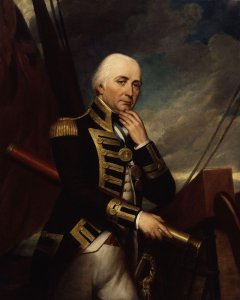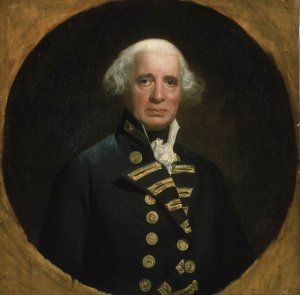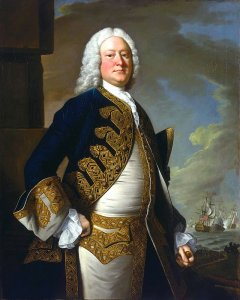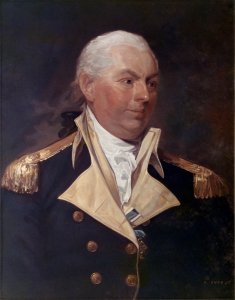Today in Naval History - Naval / Maritime Events in History
6th of March
some of the events you will find here,
please use the following link where you will find more details and all other events of this day .....
1780 – Launch of French Vénus, a 32-gun frigate of the French Navy.
The Vénus was a 32-gun frigate of the French Navy.
She was launched in Saint-Malo in 1780. Her main duties were escorting convoys between Île de Ré, Nantes and Brest. In this capacity, she captured a British privateer on 16 June.
She was wrecked on 5 August 1781 near Glénan Islands, off Concarneau, when she ran aground due to a navigation error of the pilot. The crew was saved, but in spite of efforts to refloat her, she became a total loss.

1782 – Launch of French Suffisant, a 74-gun Pégase-class ship of the line of the French Navy
The Suffisant was a 74-gun Pégase-class ship of the line of the French Navy, launched in 1782. She served during the last months of the American War of Independence, and survived to see action in the French Revolutionary Wars.

1787 – Launch of HMS Vanguard, a 74-gun Arrogant-class third-rate ship of the line of the Royal Navy
HMS Vanguard was a 74-gun third-rate ship of the line of the Royal Navy, launched on 6 March 1787 at Deptford. She was the sixth vessel to bear the name.
In December 1797, Captain Edward Berry was appointed flag captain, flying Rear Admiral Sir Horatio Nelson's flag.

Victory, Captain, Agamemnon, Vanguard & Elephant (Print) (PAD5986)
1808, March 6–8 – HMS San Fiorenzo captures French frigate Piémontaise
The Piémontaise was a 40-gun Consolante-class frigate of the French Navy. She served as a commerce raider in the Indian Ocean until her capture in March 1808. She then served with the British Royal Navy in the East Indies until she was broken up in Britain in 1813.

HMS St Fiorenzo capturing Piémontaise on 9 March 1808

San Fiorenzo (far left) and Nymphe (second from right) capture Résistance and Constance, 9 March 1797. Oil painting by Nicholas Pocock.
1809 – Launch of HMS Malacca, an Apollo-class frigate of the Royal Navy that the Admiralty ordered from the British East India Company to be built at Prince of Wales Island (Penang), under the name Penang.
HMS Malacca was an Apollo-class frigate of the Royal Navy that the Admiralty ordered from the British East India Company to be built at Prince of Wales Island (Penang), under the name Penang. Prior to her launch in 1809 the Admiralty changed her name to Malacca, but she sailed to England in 1810 as Penang. The Navy commissioned her as Malacca in 1810 and sent her out to the East Indies. She had a brief career there, participating in one small punitive expedition, before she was paid-off in 1815 and broken up in 1816.


1836, March 6 – Texas schooner Liberty captures the Mexican schooner Pelicano
The Texas schooner Liberty was one of the four schooners of the First Texas Navy (1836–1838). She served in the Texas Navy for only about 6 months, capturing the Mexican brig Pelicano loaded with weapons for their army in Texas. Later that year, she sailed to New Orleans accompanying the wounded Sam Houston, where she was repaired. Texas was unable to pay for the repairs and the ship was sold in June, 1836, to pay for the cost of the repairs. This left the Texas Navy with only three ships.

1874 – Launch of The corbeta (corvette) ARA Uruguay, built in England, is the largest ship afloat of its age in the Armada de la República Argentina (Argentine Navy)
The corbeta (corvette) ARA Uruguay, built in England, is the largest ship afloat of its age in the Armada de la República Argentina (Argentine Navy), with more than 140 years passed since its commissioning in September 1874. The last of the legendary squadron of President Sarmiento, the Uruguay took part in revolutions, ransoms, expeditions, rescues, and was even floating headquarters of the Navy School. During its operational history 1874–1926 the Uruguay has served as a gunboat, school ship, expedition support ship, Antarctic rescue ship, fisheries base supply ship, and hydrographic survey vessel, and is now a museum ship in Buenos Aires. This ship may be the oldest in South America having been built in 1874 at Laird Bros. (now Cammell Laird) shipyard of Birkenhead, England, at a cost of £32,000. This ship is rigged to a barque sailplan (three masts, two of which have cross spars). The ship's steel hull is lined in teak.
The ship's namesake is an earlier Argentine Navy schooner, a seven-gun combatant in the Battle of Juncal, 1827.

1938 - spanish Canarias-class heavy cruiser Baleares sunk by the Lepanto - 765 seamen died.
Baleares was a Canarias-class heavy cruiser of the Spanish Navy. The two ships of the class were built upon a British design and were a modified version of the Royal Navy′s County class. Baleares was constructed in Spain by the Vickers-Armstrongs subsidiary Sociedad Española de Construcción Naval, and saw service during the Spanish Civil War, when she was torpedoed and sunk by destroyers of the Spanish Republican Navy during the Battle of Cape Palos.

1940 – Launch of French Jean Bart, a French battleship of World War II, named for the 17th-century seaman, privateer, and corsair Jean Bart.
Jean Bart was a French battleship of World War II, named for the 17th-century seaman, privateer, and corsair Jean Bart. She was the second Richelieu-class battleship. Derived from the Dunkerque class, Jean Bart (and her sister ship Richelieu) were designed to fight the new battleships of the Italian Navy. Their speed, shielding, armament, and overall technology were state of the art, but they had a rather unusual main battery armament arrangement, with two 4-gun turrets forward and none aft.
Jean Bart was incomplete when France surrendered to Germany in June 1940. She sailed from Saint-Nazaire to Casablanca just before the Armistice. She was sunk in harbour in 1942. After the war she was re-floated, completed with an updated anti-aircraft battery, and entered service in 1955. She had a very short career: Jean Bart was put into reserve in 1957, decommissioned in 1961, and scrapped in 1969.

Jean Bart in the harbor of Casablanca, photographed by a plane from USS Ranger. Turret number two was not yet operational.
1943 - Battle of Blackett Strait - an American task force intercepts 2 Japanese destroyers and sinks them both.
The Battle of Blackett Strait (Japanese: ビラ・スタンモーア夜戦 Battle of Vila-Stanmore) was a naval battle of the Pacific campaign of World War II, fought on 6 March 1943 in the Blackett Strait, between Kolombangara islands and Arundel Island in the Solomon Islands.

1987 – The British ferry MS Herald of Free Enterprise capsizes in about 90 seconds, killing 193.
MS Herald of Free Enterprise was a roll-on/roll-off (RORO) ferry which capsized moments after leaving the Belgian port of Zeebrugge on the night of 6 March 1987, killing 193 passengers and crew.

6th of March
some of the events you will find here,
please use the following link where you will find more details and all other events of this day .....
Naval/Maritime History - 27th of August - Today in Naval History - Naval / Maritime Events in History
Today in Naval History - Naval / Maritime Events in History 5 March 1800 – 36-gun frigate HMS Phoebe captures the 22-gun privateer Heureux Heureux was a 22-gun French privateer brig that the British captured in 1800. She served with the Royal Navy as the 22-gun post ship HMS Heureux. She...
shipsofscale.com
1780 – Launch of French Vénus, a 32-gun frigate of the French Navy.
The Vénus was a 32-gun frigate of the French Navy.
She was launched in Saint-Malo in 1780. Her main duties were escorting convoys between Île de Ré, Nantes and Brest. In this capacity, she captured a British privateer on 16 June.
She was wrecked on 5 August 1781 near Glénan Islands, off Concarneau, when she ran aground due to a navigation error of the pilot. The crew was saved, but in spite of efforts to refloat her, she became a total loss.
1782 – Launch of French Suffisant, a 74-gun Pégase-class ship of the line of the French Navy
The Suffisant was a 74-gun Pégase-class ship of the line of the French Navy, launched in 1782. She served during the last months of the American War of Independence, and survived to see action in the French Revolutionary Wars.
1787 – Launch of HMS Vanguard, a 74-gun Arrogant-class third-rate ship of the line of the Royal Navy
HMS Vanguard was a 74-gun third-rate ship of the line of the Royal Navy, launched on 6 March 1787 at Deptford. She was the sixth vessel to bear the name.
In December 1797, Captain Edward Berry was appointed flag captain, flying Rear Admiral Sir Horatio Nelson's flag.
Victory, Captain, Agamemnon, Vanguard & Elephant (Print) (PAD5986)
1808, March 6–8 – HMS San Fiorenzo captures French frigate Piémontaise
The Piémontaise was a 40-gun Consolante-class frigate of the French Navy. She served as a commerce raider in the Indian Ocean until her capture in March 1808. She then served with the British Royal Navy in the East Indies until she was broken up in Britain in 1813.
HMS St Fiorenzo capturing Piémontaise on 9 March 1808
San Fiorenzo (far left) and Nymphe (second from right) capture Résistance and Constance, 9 March 1797. Oil painting by Nicholas Pocock.
1809 – Launch of HMS Malacca, an Apollo-class frigate of the Royal Navy that the Admiralty ordered from the British East India Company to be built at Prince of Wales Island (Penang), under the name Penang.
HMS Malacca was an Apollo-class frigate of the Royal Navy that the Admiralty ordered from the British East India Company to be built at Prince of Wales Island (Penang), under the name Penang. Prior to her launch in 1809 the Admiralty changed her name to Malacca, but she sailed to England in 1810 as Penang. The Navy commissioned her as Malacca in 1810 and sent her out to the East Indies. She had a brief career there, participating in one small punitive expedition, before she was paid-off in 1815 and broken up in 1816.
1836, March 6 – Texas schooner Liberty captures the Mexican schooner Pelicano
The Texas schooner Liberty was one of the four schooners of the First Texas Navy (1836–1838). She served in the Texas Navy for only about 6 months, capturing the Mexican brig Pelicano loaded with weapons for their army in Texas. Later that year, she sailed to New Orleans accompanying the wounded Sam Houston, where she was repaired. Texas was unable to pay for the repairs and the ship was sold in June, 1836, to pay for the cost of the repairs. This left the Texas Navy with only three ships.
1874 – Launch of The corbeta (corvette) ARA Uruguay, built in England, is the largest ship afloat of its age in the Armada de la República Argentina (Argentine Navy)
The corbeta (corvette) ARA Uruguay, built in England, is the largest ship afloat of its age in the Armada de la República Argentina (Argentine Navy), with more than 140 years passed since its commissioning in September 1874. The last of the legendary squadron of President Sarmiento, the Uruguay took part in revolutions, ransoms, expeditions, rescues, and was even floating headquarters of the Navy School. During its operational history 1874–1926 the Uruguay has served as a gunboat, school ship, expedition support ship, Antarctic rescue ship, fisheries base supply ship, and hydrographic survey vessel, and is now a museum ship in Buenos Aires. This ship may be the oldest in South America having been built in 1874 at Laird Bros. (now Cammell Laird) shipyard of Birkenhead, England, at a cost of £32,000. This ship is rigged to a barque sailplan (three masts, two of which have cross spars). The ship's steel hull is lined in teak.
The ship's namesake is an earlier Argentine Navy schooner, a seven-gun combatant in the Battle of Juncal, 1827.
1938 - spanish Canarias-class heavy cruiser Baleares sunk by the Lepanto - 765 seamen died.
Baleares was a Canarias-class heavy cruiser of the Spanish Navy. The two ships of the class were built upon a British design and were a modified version of the Royal Navy′s County class. Baleares was constructed in Spain by the Vickers-Armstrongs subsidiary Sociedad Española de Construcción Naval, and saw service during the Spanish Civil War, when she was torpedoed and sunk by destroyers of the Spanish Republican Navy during the Battle of Cape Palos.
1940 – Launch of French Jean Bart, a French battleship of World War II, named for the 17th-century seaman, privateer, and corsair Jean Bart.
Jean Bart was a French battleship of World War II, named for the 17th-century seaman, privateer, and corsair Jean Bart. She was the second Richelieu-class battleship. Derived from the Dunkerque class, Jean Bart (and her sister ship Richelieu) were designed to fight the new battleships of the Italian Navy. Their speed, shielding, armament, and overall technology were state of the art, but they had a rather unusual main battery armament arrangement, with two 4-gun turrets forward and none aft.
Jean Bart was incomplete when France surrendered to Germany in June 1940. She sailed from Saint-Nazaire to Casablanca just before the Armistice. She was sunk in harbour in 1942. After the war she was re-floated, completed with an updated anti-aircraft battery, and entered service in 1955. She had a very short career: Jean Bart was put into reserve in 1957, decommissioned in 1961, and scrapped in 1969.
Jean Bart in the harbor of Casablanca, photographed by a plane from USS Ranger. Turret number two was not yet operational.
1943 - Battle of Blackett Strait - an American task force intercepts 2 Japanese destroyers and sinks them both.
The Battle of Blackett Strait (Japanese: ビラ・スタンモーア夜戦 Battle of Vila-Stanmore) was a naval battle of the Pacific campaign of World War II, fought on 6 March 1943 in the Blackett Strait, between Kolombangara islands and Arundel Island in the Solomon Islands.
1987 – The British ferry MS Herald of Free Enterprise capsizes in about 90 seconds, killing 193.
MS Herald of Free Enterprise was a roll-on/roll-off (RORO) ferry which capsized moments after leaving the Belgian port of Zeebrugge on the night of 6 March 1987, killing 193 passengers and crew.






 Shipbuilding and Drydock Company
Shipbuilding and Drydock Company
